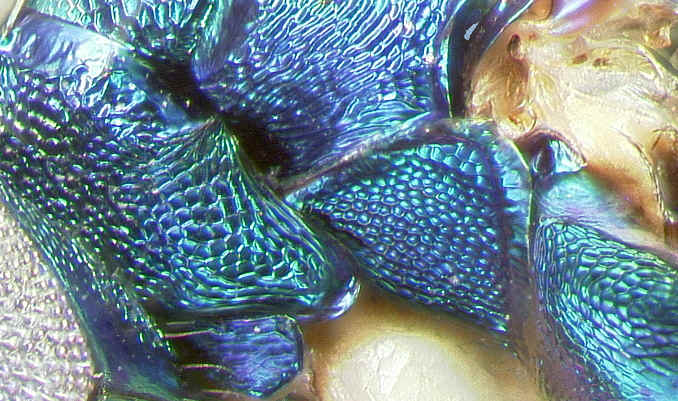1a-b: Achrysocharoides clypeatus (Miller) female face (left), and A. arienascapus male face (right)
return to: Eul 1 Eul 4 eud 1 eul 1 ent 1 ent 5 ent 10 ent 13 ent 16 ent 21 ent 26
Achrysocharoides Girault, 1913 comparative
info return to: prev home
Eyes densely setose. Mandibles with 3 or more denticles. Transverse
frontal groove always straight, not v-shaped (but can bend medially if face is
collapsed); scrobal depressions reaching transverse groove separately or uniting before
reaching groove, always broadly separated ventrally and never extending below toruli.
Occiput sometimes sharply margined, usually without longitudinal groove. Clypeus not
delimited by sutures. Flagellar formula usually 3,3,2, sometimes 3,4,1 in males; apical
anellus usually much broader than long, rarely subquadrate; heads of peg sensilla of
flagellum rounded, symmetrical; postanellar flagellomeres generally longer than
broad, rarely about as long as broad; club with apical spicule. Lateral
panel of pronotum with a semicircular ridge; mesoscutum and especially
scutellum often with distinct groups of pits or longitudinal foveae;
mesoscutal midlobe with 2 pairs of setae; notauli bent sharply laterad anteriorly.
Postmarginal vein usually about 1x stigmal vein length, rarely up to 1.4x stigmal vein
length (in which case scutellum has groups of pits); no setal tracks radiating from
stigma; stalk of stigmal vein long, such that stigma appears petiolate [as opposed to that
of Horismenus, etc.]. Propodeum smooth or with 1 or 2 median carinae; very rarely
with plicae (in A. littoralis Kamijo), or paraspiracular carina (a few species);
with distinct spiracular groove. Petiole hardly or not longer than broad (at most 1.5x
longer than broad), weakly sculpted at most. Compare with: Chrysocharis,
Holarcticesa, Closterocerus, Pediobius,
Chrysonotomyia.
1a-b: Achrysocharoides clypeatus (Miller) female face (left), and A.
arienascapus male face (right)

2a. Achrysocharoides pronotum and prepectus

3a. Achrysocharoides mesosoma (dorsal)
Biology: Parasitoids of leaf-mining Lepidoptera, mainly Phyllonorycter [Gracillariidae].
Comments: Some species of this genus are very difficult to distinguish from Chrysocharis, although the criteria given here will serve to separate all specimens of confirmable identity that I have examined. This genus is also difficult to separate from Kratoysma on an absolute basis, although in most cases they are easily separated by sculpture and the fact that Achrysocharoides species seldom have propodeal plicae and a carinate pronotal collar. Achrysocharoides littoralis Kamijo has both of these states, but has a median propodeal channel rather than the single carina present in Kratoysma. Gumovsky (2001) discovered that the semicircular ridge on the lateral panel of the pronotum is apparently a generic character. I have not focused on this character in the cases where it would be useful (ie: distinction from Chrysocharis) because I have found several species of Chrysocharis that possess this ridge as well. Its presence throughout the subfamily is poorly known, and it is a difficult character to accurately assess.
Comparative information: No other genus has any species with pits on the scutellum or mesoscutum. Characters below serve to separate Achrysocharoides without such pits from similar genera.
Chrysocharis: Combination of characters defining Achrysocharoides not completely present: Transverse frontal groove usually v-shaped. Petiole often more than 1.5x longer than broad (never more than 1.5x longer than broad in Achrysocharoides). Eyes often not visibly setose under normal magnification (10-50x). Postmarginal vein usually >1.4x stigmal vein length. Problematic species of Chrysocharis, those with a straight transverse frontal groove, are disqualified from being Achrysocharoides by having one or more of the characters that Achrysocharoides cannot have. This situation is unfortunate, and may mean that some species of one genus may be more closely related to the type species of the other.
Holarcticesa: Flagellar formula strictly 1,4,1 [anellus very tiny, could easily be interpreted as absent]; scape relatively long and narrow: about 5x longer than broad, strongly flattened laterally. Postmarginal vein about 2x stigmal vein length.
Closterocerus: Interscrobal ridge always meeting transverse groove, which is near the median ocellus when straight; scrobal grooves extending slightly below toruli. Transverse frontal groove straight only in the subgenus Achrysocharis, most species of which have only 1 pair of setae (always the posterior pair) on the mesoscutal midlobe. Funicular segments transverse in some species. Heads of peg sensilla of flagellum always slanting, asymmetrical; sensory pores of scape in a cluster near apex of scape in males.
Pediobius: Confusable with those Achrysocharoides that have a pair of submedian carinae. Petiole always densely punctate or rugose, over 1/3 propodeal width and with a dorsal anterior carina. Pronotal collar and vertex carinate in most species. Stigmal vein very short, stigma generally not appearing petiolate.
Chrysonotomyia: Clypeus set off by distinct sutures. Transverse frontal groove near median ocellus, defined by scrobal grooves that are very close-together throughout their length. Mesoscutal midlobe with 1 pair of setae (the posterior pair). 2 setal tracks radiating from stigma.
References
Askew, R.R. & Ruse, J.M. 1974. Biology and taxonomy of the species of the genus Enaysma Delucchi (Hym., Eulophidae, Entedoninae) with special reference to the British fauna. Transactions of the Royal Entomological Society of London. 125: 257-294.
Bryan, G. 1980. The British species of Achrysocharoides (Hymenoptera, Eulophidae). Systematic Entomology. 5: 245-262.
Gumovsky, A.V. 2001. The status of some genera allied to Chrysonotomyia and Closterocerus (Hymenoptera: Eulophidae, Entedoninae), with description of a new species from Dominican Amber. Phegea 29(4): 125-141.
Hansson, C. 1983. Taxonomic notes on the genus Achrysocharoides Girault, 1913 (Hymenoptera: Eulophidae), with a redescription and a description of a new species. Entomologica Scandinavica. 14: 281-291.
Hansson, C. 1985. The entedonine genera Achrysocharoides Girault, Chrysocharis Förster and Kratoysma Boucek (Hymenoptera: Eulophidae) in the Oriental region. Entomologica Scandinavica. 16: 217-226.
Kamijo, K. 1990. Five new species of Achrysocharoides (Hymenoptera, Eulophidae) associated with Leguminosae in Japan. Japanese Journal of Entomology. 58(2): 293-302.
Kamijo, K. 1991. Revision of North American Achrysocharoides (Hymenoptera: Eulophidae). Akitu (new series). 124: 1-34.
Schauff, M.E. 1991. The Holarctic genera of Entedoninae (Hymenoptera: Eulophidae). Contributions of the American Entomological Institute 26.
Yoshimoto, C. 1977. The North American species of the genus Achrysocharoides (Hymenoptera: Eulophidae). Canadian Entomologist. 109: 907-930.
Image credits: 1a-b: Kamijo (1991).